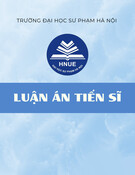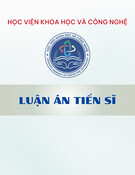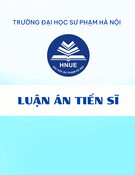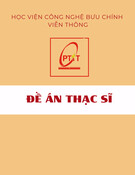
MINISTRY OF EDUCATION AND TRAINING
NHA TRANG UNIVERSITY
NGUYỄN THỊ THĂNG LONG
RESEARCH RECEIVING AND MAKING FROM INULIN POWDER
FROM DANGSHEN TUBERS (CODONOPSIS JAVANICA) GROW NATURALLY
IN LAC DUONG DISTRICT - LAM DONG PROVINCE
SUMMARY Ph.D. THESIS
KHANH HOA - 2021

i
The thesis is completed at the Nha Trang University
Science instructor:
1. Assoc. Prof. Dr. Vũ Ngọc Bội
2. Assoc. Prof. Dr. Đào Xuân Vinh
Reviewer 1: Prof. Dr. Nguyen Thi Thanh Mai
Reviewer 2: Assoc. Prof. Dr. Phung Thi Thanh Tu
Reviewer 3: Prof. Dr. Nguyen Anh Dung
The thesis is defended at the Nha Trang University Council, meeting at the
Nha Trang University at the hour 8 Date 28 Month 11 Year 2021
The thesis can be found at: National Library and the Nha Trang University Library

1
SUMMARY OF THE DOCTORAL THESIS’S NEW CONTRIBUTIONS
Thesis topic: “Research on extracting and making inulin powder from Dangshen 's roots (Codonopsis
javanica) naturally growing in Lac Duong district, Lam Dong province”.
Mayor: Post Harvest Technology Code: 9540104
Ph.D. Candidate: Nguyễn Thị Thăng Long Year: 2015-2019
The scientific advisors: Assoc. Prof. Dr. Vũ Ngọc Bội
Assoc. Prof. Dr. Đào Xuân Vinh
University: The Nha Trang University
Content:
The thesis has obtained some new results added to the field of research, spray drying to create
inulin powder from Dangshen (Codonopsis javanica) and making synbiotic preparations from inulin
for application in functional foods:
1)The thesis has researched and determined for the first time the morphological and structural
features of the isotropic root tissue (Codonopsis javanica) that grows naturally in Lac Duong - Lam
Dong as the basis for age discrimination and timing. Harvesting Dangshen roots. On the other hand,
the thesis also determined that 3-year-old Dangshen root has ingredients that meet Vietnamese
pharmacopeia standards in 2017: Total sugar content: (10.08 ± 0.88) oBx, Total extract content:(58.2
± 1.57) g/100g; Total mineral content: (5.50 ± 0.17) %, containing inorganic impurities and heavy
metals.
2)The thesis has first time researched and optimized the inulin extraction process from
Codonopsis javanica that naturally grows in Lac Duong Lam Dong: the extraction solvent is distilled
water of two times, extraction temperature 71oC, extraction time, 36 minutes, and the ratio of solvents
/ raw materials is 47ml/g with 23.93 % inulin extraction efficiency, 26.96 % fructan extraction
efficiency, and 61.35 % of total dissolved extraction efficiency. The thesis also identifies the right
factors for inulin precipitation: the appropriate temperature to concentrate the extraction before
precipitating to 16 oBx is under 55oC, the suitable precipitation agent is ethanol, the concentration of
ethanol is fit. The content for inulin precipitation is 80%, and ethanol concentration for fructan
precipitation is 90%, temperature for inulin precipitation is (6±1)°C with average precipitation
efficiency of 95.53%.
3) The thesis studies for the first time on purification and determination of the molecular structure
characteristics of inulin obtained. The study results showed that it is possible to purify inulin from
crude extracts by recrystallization six times, and the purified inulin collection efficiency is (75.85±0.84)
%. The purified inulin obtained from Codonopsis javanica naturally grows in Lac Duong-Lam Dong
includes two molecules of Fructose polysaccharide: a molecule with a mass of 3.193 Da, about 19-23
monomers, depict at 96.448 %, and one the molecule has a molecular weight of 1.112.892 Da,
accounting for 3.552%.
4) The dissertation identifies for the first time some parameters suitable for the spray inulin
powdered in Codonopsis javanica. The drying aid is maltodextrin, with the appropriate additional

2
maltodextrin ratio of 10 %. The inlet temperature is 185oC, and the drying chamber air temperature is
85oC; The compressed air pressure is 3 atm, the input pump speed is 10ml/p, which corresponds to the
injector speed of 16000 rpm. The powder obtained had an inulin content of (445.90 ± 2.79) mg/g;
Fructan content reached (469.40 ±1.61) mg/g, pH (5.18 ± 0.01), mineral content (4.82 ± 0.07) %.
Solubility: 1/ 9.5 ± 0.5 / 15 (g / ml/ min; Humidity (6.06 ± 0.27) % and free of inorganic impurities and
heavy metals. particle size (882.2±101.4) ƞm, particle density 100%, dispersion 0.497 PDI, melting
temperature over 600oC. The powder meets food safety standards according to current regulations of
the Ministry of Health for functional food.
5) The thesis has done for the first time by using inulin powder from Dangshen to make synbiotic
products to apply in food and obtained some results Dangshen spray- powder containing Inulin has
strong prebiotic properties with a dose of 4% (w/w- equivalent to 1.8 -2% based on inulin content) can
stimulate cell proliferation (CFU) of 8 strains ( two of L. acidophilus, L. plantarum, L. rhamnosus, B.
longum, B. lactic, two of Enterococcus faecalis) from 1.4 ÷ 11.5 times, in which, L. acidophillus (M7)
had the highest fertility rate of 2.3 x1011CFU/ g and Enterococcus faecalis (M4) had the lowest fertility
rate of 7x10 6 CFU/ g.
6) The thesis first has identified the synbiotic mixing formula for the first time: Inulin powder
0.514 g/g mixed with L. acidophillus biomass 0.33 g/g (density 5x1010CFU/ g); 0.128 g/ g L. plantarum
biomass (density 2x1011CFU/ g); 0.033 g/g B. longum (density 8 x1010CFU / g) and 0.1 g/g of B. lactics
biomass (density 1011CFU/ g).
7) The thesis tests synbiotic products for the first time in mice. Results, synbiotic's doses of 1.2 g/
kg and 2.4 g/ kg using for 14 or 28 days were not acute toxicity, semi-chronic toxicity to the liver's
function, and to the kidney in test rats. Synbiotic has immunostimulating properties as well as the ability
to treat diarrhea in mice.
DIRECTORS
Ph.D. Student
Assoc. Prof. Dr. Vũ Ngọc Bội
Assoc. Prof. Dr. Đào Xuân Vinh
Nguyễn Thị Thăng Long

3
THE SUMMMARY OF THE THESIS
INTRODUCTION
1. The necessary of the thesis
The herbs extract substances with outstanding features of being non-toxic, having no side effects, and
multi-effects should be used as functional foods and gradually as a substitute for medicines.
On October 30 in 2013, the Prime Minister Issued Decision 1976/QD-TTG on "Overall development
of medicinal herbs to 2020 and orientations to 2030", which focused on 28 indigenous medicinal herbs,
including Dangshen (Codonopsis javanica). According to this trend, researchers are interested in the study
of extracting and acquiring pure substances from plants in general and naturally growing railway to improve
the effectiveness of herbal application in all fields.
Special natural conditions made 1664 Lam Dong province has 237 species of plant families,
representing nearly 50% of medicinal plants in the country. Besides, Lam Dong province is being also
planned as herbal of the primary region.
For the above reasons, the project of Ministry level has been implemented by me of the research about
“Studying the chemical composition of the Đanshen (Codonopsis javanica) in Lam Dong and the
application on functional foods”. Code B2018-DLA-01. Basing on funding from the Ministry-level project,
I made the thesis on “Research on inulin collection and production from Codonopsis javanica naturally
growing in Lac Duong - Lam Đong province”.
2. The goal of the thesis
Determine the time of harvesting the natural growing Dangshen roots.
Research on inulin extraction, purification, and characterization of inulin molecular structure in
Dangshen tubers naturally growing in Lac Duong district, Lam Dong province.
Research on spray drying to create Dangshen powder and experiment to create a synbiotic powder
from spray-drying powder, oriented application in food.
3. Object and scope of research
Object: The raw materials used in the harvesting time study were fresh, mixed at random collection.
The raw materials used to extract Inulin are Dangshen ’s residue after extraction of other ingredients
by organic solvents (n-hexane, ethanol).
4. Research scope
1) Research to determine the harvesting time of wild Dangshen in Lac Duong district, Lam Dong
province.
2) Optimizing research on inulin extraction from naturally grown Dangshen
3) Purification study and characterization of the inulin molecular structure obtained.
4) Research on spray drying to create inulin powder.
5) Testing using spray-dried Dangshen powder to create a synbiotic powder, oriented application in
food.
5. Research Methodology


























